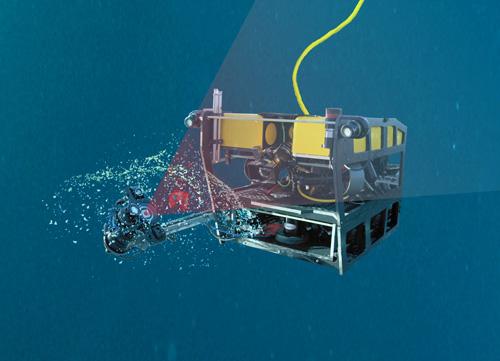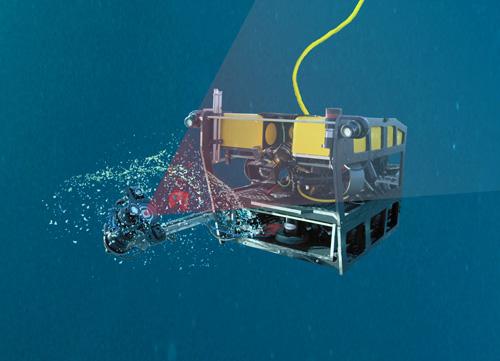
Credit: Kim Fulton-Bennett (c) 2017 MBARI
MOSS LANDING, CA–New laser technology is allowing MBARI scientists to look into the structure of giant larvaceans-tadpole-like marine animals that are important players in ocean ecosystems. In a recent paper in Science Advances, MBARI researchers described a new method for measuring the flow of seawater through larvaceans and other gelatinous animals. The results will help scientists understand how much carbon dioxide the oceans are absorbing from the atmosphere.
Larvaceans play a significant role in moving carbon from the upper part of the ocean down into the deep sea. They build balloon-like mucus structures called "houses," which concentrate food by filtering tiny particles out of the surrounding seawater. These particles contain organic carbon, some of which originated as carbon dioxide in the atmosphere.
Over time their filters become overloaded with particles, and the larvacean abandons its house. The discarded houses collapse and sink rapidly to the seafloor, carrying carbon into the deep sea. Once on the seafloor, this carbon is consumed by animals or buried in seafloor sediment. The buried carbon is likely to be removed from the atmosphere for millions of years.
Because giant larvaceans are just centimeters in length, but build houses that can be a meter across, they are a challenge to study. Intact larvacean houses are nearly impossible to collect in a net or jar, or to contain in a laboratory aquarium. Once they drift into a solid net or wall, the houses fall apart.
Instead of trying to build a tank large enough to harbor a giant larvacean and its house, MBARI Postdoctoral Fellow Kakani Katija has been investigating ways to study larvaceans in the open ocean, using a technique called particle image velocimetry (PIV). PIV systems have been used in laboratories for decades to observe and measure complex water-flow patterns such as currents, swirls, and eddies.
In 2015 Katija set out to adapt a PIV system for use in the deep sea. Her "DeepPIV" system consists of a laser that emits a thin sheet of light and a video camera that records tiny particles in the water, which are lit up by the laser as they pass through this sheet of light. Working with MBARI engineers Alana Sherman, Dale Graves, and Chad Kecy, Katija mounted the laser and video camera on MBARI's MiniROV, a small remotely operated vehicle (ROV).
Later that year Katija joined Senior Scientist Bruce Robison and the rest of the DeepPIV team in their first field test, using the MiniROV to dive 1,200 meters (4,000 feet) below the surface of Monterey Bay.
When the team spotted their first giant larvacean, the ROV pilot turned on the lasers, switched off the ROV's lights, and held the ROV in position while a sheet of laser light scanned through the larvacean's body and house. Some of the scientists on the cruise had studied giant larvaceans for years, but when the laser switched on, suddenly they could see chambers and passageways in the larvacean's house that they never knew existed.
"We were all shocked by how well it worked," said Katija. "There was a lot of oohing and aahing in the control room. It wasn't just the scientists who were shocked and amazed–it was everyone on the research vessel."
Robison commented, "DeepPIV allowed us to look inside a complex structure that we had only seen from the outside before. As a result, we learned more about giant larvaceans during a single dive than we had in the previous couple of decades."
Eventually Katija was able to videotape the flow of particles within the houses of 24 giant larvaceans over the course of 13 different ROV dives. Analyzing the footage from these dives, Katija measured how fast the particles were moving. From this information she could calculate how much water the larvaceans were filtering through their houses.
Katija's calculations showed that each giant larvacean in Monterey Bay could filter up to 76 liters (20 gallons) of water per hour. This is four times higher than previous estimates for giant larvaceans and five times higher than filtering rates by other gelatinous open-ocean filter feeders, such as salps.
Coupling her filtering estimates with MBARI's long-term data on the abundance of giant larvaceans at various depths, Katija calculated the total volume of water filtered by giant larvaceans in Monterey Bay. During the spring months, when they are most abundant, Katija estimated that larvaceans could filter all the water between 100 and 300 meters in Monterey Bay in as little as 13 days. That's the equivalent of 500 Olympic-sized swimming pools per hour.
Katija's research shows that larvaceans play an even larger role than scientists had previously thought in removing carbon from the surface ocean. In her paper, she noted that DeepPIV could also be used to measure filtration rates of other midwater animals. These data will help scientists understand how much carbon deep-sea animals are removing from the oceans and (indirectly) from the atmosphere. Such information is vital for improving computer models of climate change.
Following up on her initial success with the DeepPIV, Katija has been collaborating with MBARI biologist Jim Barry to understand how deep-sea corals and sponges gather tiny food particles carried by ocean currents. "Now that DeepPIV is available to the oceanographic community," Katija said, "it opens up all kinds of possibilities."
###
Original journal article:
Katija, K., Sherlock, R.E., Sherman, A D, Robison, B. H. (2017). New technology reveals the role of giant larvaceans in oceanic carbon cycling. Science Advances, 3: doi: e1602374
Online news release with images: http://www.mbari.org/lasers-shed-light-on-the-inner-workings-of-the-giant-larvacean/
MBARI YouTube video on this research: https://youtu.be/0fCnHyxYVMw
Media Contact
Kim Fulton-Bennett
[email protected]
831-775-1835
@MBARI_news
############
Story Source: Materials provided by Scienmag





